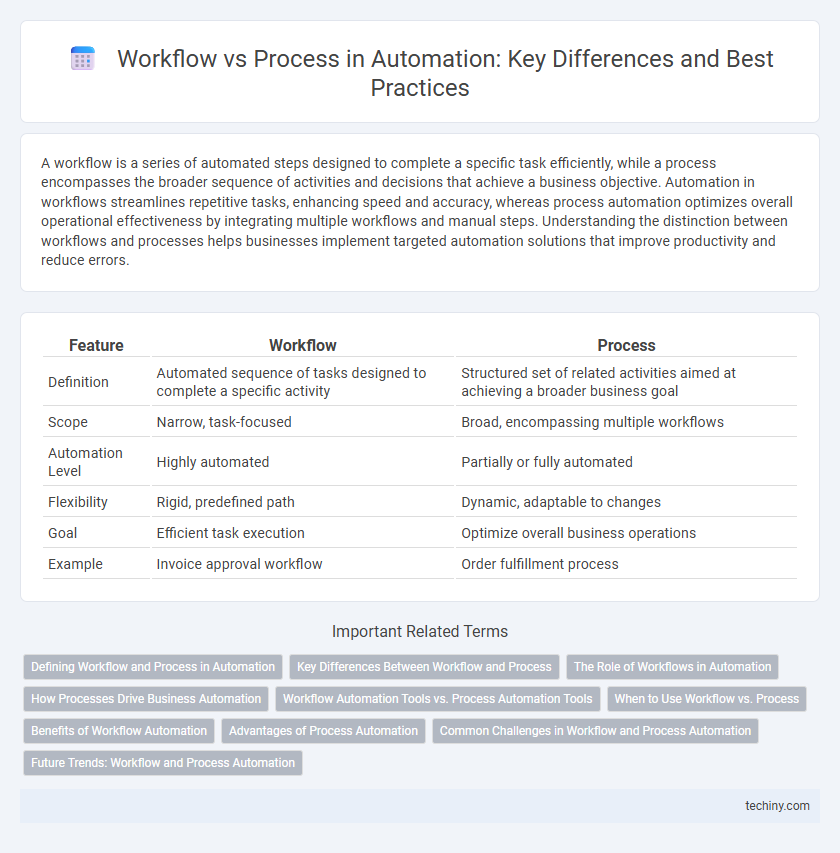A workflow is a series of automated steps designed to complete a specific task efficiently, while a process encompasses the broader sequence of activities and decisions that achieve a business objective. Automation in workflows streamlines repetitive tasks, enhancing speed and accuracy, whereas process automation optimizes overall operational effectiveness by integrating multiple workflows and manual steps. Understanding the distinction between workflows and processes helps businesses implement targeted automation solutions that improve productivity and reduce errors.
Table of Comparison
| Feature | Workflow | Process |
|---|---|---|
| Definition | Automated sequence of tasks designed to complete a specific activity | Structured set of related activities aimed at achieving a broader business goal |
| Scope | Narrow, task-focused | Broad, encompassing multiple workflows |
| Automation Level | Highly automated | Partially or fully automated |
| Flexibility | Rigid, predefined path | Dynamic, adaptable to changes |
| Goal | Efficient task execution | Optimize overall business operations |
| Example | Invoice approval workflow | Order fulfillment process |
Defining Workflow and Process in Automation
A workflow in automation refers to a sequence of automated tasks designed to achieve a specific outcome by orchestrating various activities and decision points. A process encompasses a broader set of interrelated workflows and manual tasks aimed at delivering an end-to-end business objective with defined inputs, outputs, and performance metrics. Understanding the distinction between workflow and process is crucial for optimizing automation strategies and improving operational efficiency.
Key Differences Between Workflow and Process
A workflow represents the sequence of tasks and activities automated or manual to achieve a specific outcome, emphasizing task flow and task dependencies. A process is a broader concept involving a set of interrelated activities and resources designed to transform inputs into outputs, often encompassing multiple workflows within its scope. Key differences include that workflows focus on task execution and automation details, while processes emphasize overall objectives, inputs, outputs, and performance measurement.
The Role of Workflows in Automation
Workflows in automation streamline repetitive tasks by defining a sequence of actions that occur automatically, reducing human intervention and error. These structured workflows enable efficient task routing, approval processes, and data integration, accelerating business operations and improving consistency. Unlike broader processes, workflows serve as the actionable steps within automation systems that drive seamless task execution and optimize resource allocation.
How Processes Drive Business Automation
Processes drive business automation by defining a structured sequence of tasks that ensure consistency, efficiency, and scalability across operations. Workflows represent the specific execution paths within these processes, enabling automated task routing, decision-making, and real-time monitoring. Establishing clear processes allows organizations to leverage automation technologies effectively, resulting in reduced manual effort, minimized errors, and accelerated business outcomes.
Workflow Automation Tools vs. Process Automation Tools
Workflow automation tools streamline repetitive tasks by mapping out sequential steps to improve efficiency in specific work activities, often integrating with applications like email or project management software. Process automation tools address broader, end-to-end business processes, enabling complex rule-based decision-making and data handling across multiple departments for comprehensive digital transformation. Enterprise platforms such as Zapier and Microsoft Power Automate exemplify workflow automation, while solutions like IBM BPM and Appian demonstrate advanced process automation capabilities.
When to Use Workflow vs. Process
Use a workflow when you need to automate repetitive tasks with defined steps, ensuring consistency and efficiency in routine operations. Opt for a process when managing broader, more complex activities that require coordination among multiple functions and decision points. Choosing between workflow and process depends on the scope and granularity of the tasks, with workflows best for task-level automation and processes for strategic management.
Benefits of Workflow Automation
Workflow automation streamlines repetitive tasks by defining a sequence of automated actions, boosting efficiency and reducing human error. It accelerates process execution, enhances accuracy, and improves consistency across business operations. As a result, organizations experience increased productivity, cost savings, and better compliance with standards.
Advantages of Process Automation
Process automation streamlines workflows by reducing manual tasks, increasing efficiency, and minimizing errors, leading to faster turnaround times. It enables consistent output quality through standardized procedures and real-time monitoring, enhancing overall productivity. Automated processes also offer scalability, allowing businesses to handle larger volumes without proportional increases in labor costs.
Common Challenges in Workflow and Process Automation
Workflow and process automation often face challenges such as integration complexities with legacy systems, inconsistent data flows, and lack of flexibility to adapt to evolving business requirements. Limited visibility and inadequate error handling mechanisms can cause bottlenecks, reducing overall efficiency and scalability. Ensuring seamless coordination between automated tasks and human intervention remains a crucial hurdle in achieving optimal automation outcomes.
Future Trends: Workflow and Process Automation
Future trends in workflow and process automation emphasize the integration of artificial intelligence (AI) and machine learning to enhance efficiency and decision-making. Intelligent automation streamlines complex processes by enabling dynamic task allocation and real-time data analysis. The adoption of hyper-automation frameworks accelerates digital transformation, driving continuous process optimization across industries.
Workflow vs Process Infographic

 techiny.com
techiny.com